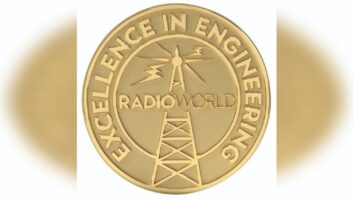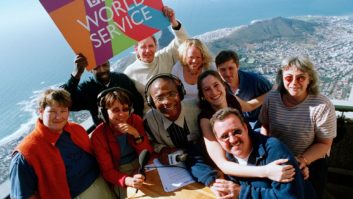
“This is NPR.” The phrase is very familiar to public radio listeners in the United States. Since its first broadcasts in 1971, National Public Radio has provided news, information and entertainment programming to the public via independent member stations who pay to carry the programming, localizing it as appropriate for their area. In recent years, NPR has expanded to offer their programming (and some of their member stations’ programming) via other outlets as well, including satellite and streaming.

HISTORY
The organization started with a relatively small staff of 90 employees from studios at 1625 I Street, NW in Washington. As it expanded, NPR moved to a larger facility at 2025 M Street, subsequently outgrew those facilities too and moved to 635 Massachusetts Ave. in 1994.
When the 635 Mass. Ave. studios were built, they were state-of-the-art. Technical amenities included large analog PR&E audio consoles, Studer reel-to-reel decks, a large selection of audio processing equipment, high-quality Benchmark distribution amplifiers and microphone preamplifiers, a master control that housed shared equipment, a spacious recording studio for musical performances or big events such as election coverage, the STC (System Technical Center) for satellite operations, and many racks” worth of patch bays for interconnecting everything. There were also, of course, walls covered with punch block terminations for all of the audio and control wiring.
After almost 18 years in that facility, it became clear that it was time once again to look at moving to a new home. General wear and tear, several expansions and renovations, and many ad-hoc integrations of new digital technology into the existing infrastructure had made for some major challenges to daily operation, particularly as new programming and technology initiatives were launched. The facility provided support not only the news and programming operation including a number of remote bureaus and studios, but also a satellite uplink infrastructure for the Public Radio Satellite System (PRSS) and other clients leasing space on the system. All of this was in addition to the traditional infrastructure required for any other large company. It was critical that an appropriate location for the new building be identified that would allow appropriate telecommunications connectivity and a clear view of the satellite arc.

LOCATION AND FUNDING
The new building is in the heart of a DC neighborhood known as NOMA, for “north of Massachusetts Ave.” This neighborhood is undergoing a transformation and revitalization as new businesses move into the area. The site originally housed the historic C&P Telephone building, which dated back to 1927. Part of that building was preserved and integrated into the new construction.
The budget for the project was approximately $200 million. Of this, $165 million came from DC Tax Exempt Bonds and $35 million came from the sale of the old building. $24 million of the budget was allocated to constructing the technology infrastructure within the facility, according to a presentation given by NPR representatives at the 2014 Public Radio Engineering Conference.

TECH CORE
In 2007, planning for the project began. In April 2013, following six years of planning and a highly compressed construction schedule, the first broadcasts from studios at NPR”s new 1111 North Capitol Street headquarters went live. Just prior to that, operations of the satellite system were migrated to a newly constructed NOC in the building, and approximately 300 of the 800 staff had been moved to their new offices. The new building will house the current staff with room for future expansion. A key requirement during the build and move process was that there be absolutely no disruption in services to stations or staff. This was no small task for a facility that provides 24/7 programming to nearly 900 stations.
The new building is seven floors and approximately 331,000 square feet. The first floor features a large lobby area, conference room, multi-function space (which features a Lawo MC266 console and can be used as a fully equipped studio), a cafeteria, and a brick-and-mortar version of the online NPR Shop. On the second floor is the satellite distribution division, including the NOC and the main tech core. The third and fourth floors house the newsroom and studios. A large open area spanning the two floors overlooks the news bullpen and MOPS (Master Operations Production Support) — the replacement for master control. The fifth through seventh floors are dedicated to office space and future expansion.

TECHNOLOGY
One of the largest changes in moving to the new facility was that while 635 Mass. Ave. had been almost exclusively analog (with digital technology bolted on over the years), 1111 North Capitol would be digital from the start.
In fact, the 10,000-square-foot tech core of the facility, with room for 350 equipment racks, is designed more like a data center than a typical broadcast rack room. Redundant UPS and generator-backed power feeds are distributed throughout the core; large HVAC systems and a robust network switching architecture ensure maximum uptime. This core is shared among all technology systems in the facility (IT, telecom, audio engineering, satellite distribution, digital media). There are virtually no punch blocks. The number of coaxial cables has been minimized as well. L-Band satellite RF between the tech core and dishes on the roof is carried via fiber. An IPTV system is used to distribute audio and video content throughout the building independent of the main production and distribution systems. Much of the infrastructure wiring was done using pre-constructed harnesses terminated in RJ-45 connectors, and many of the racks were pre-assembled and tested off-site.

MULTIPLE GROUPS, ONE MISSION
Like many organizations, NPR has multiple groups under one roof. The audio engineering group is responsible for all audio production and engineering (in connection with news and other content production groups) while distribution is responsible for getting that audio to member stations via satellite.
Lawo hardware is used on the audio engineering side for all audio routing and production. Redundant Lawo 73 HD routers are used at the audio engineering core with redundant I/O frames throughout the facility. IFB and other control functions are handled with Virtual Studio Manager (VSM) hardware and software from LSB. The various feeds from audio engineering are then handed off to an Axia Livewire based system in the NOC for distribution via satellite.
MOPS, SOPS, POCS, NOC
NPR has some unique terminology to describe its studios.

In past years, an audio engineer was almost always present when content was being produced. Now, however, much of that process has been simplified and the news staff can produce pieces with little or no assistance. The small studios that allow this are known as SOPS or Self-Operated content production studios. There are 10 of these SOPS in the facility (five pairs), each equipped with an eight-channel Lawo Crystal console, which is concealed in the furniture when not in use. Each of these pairs can be operated as two independent studios, or joined for additional functionality. These are the studios used for top of the hour newscasts. In addition to the SOPS, there are six small booths with four-channel Lawo Crystal consoles for basic production such as phone or other remote interviews.


The POCS (Program Origination Centers) are larger studios used for producing news-magazine style programs. At the heart of the POC control room is a Lawo Sapphire 24-channel console and multiple Lawo Nova 17 frames. An audio engineer operates the studio (with additional positions for directors, producers and other production personnel) while the hosts and guests are seated in a separate talk studio. These studios are spacious and can accommodate everything from an intimate one-on-one interview to a small musical ensemble. There are three POCS in the facility.

MOPS (Master Operations Production Support) is the heart of the audio engineering and production side of the house. This critical position supports all of the audio content production. Here, all feeds from the field, and from the studios are monitored and routed before heading off to the NOC for distribution. Large video displays show metering information for all critical paths at a glance. Personnel are available to assist news staff with audio production issues 24/7.

The NOC is the final stage in the chain before the audio heads out to member stations via satellite. Here, the feeds coming from MOPS are checked a final time and monitored during distribution. The NOC is also responsible for other feeds coming from sources outside of NPR to be distributed to member stations.

In the NOC are three workstations for monitoring content distribution, a pair of QC workstations for checking file based content, and a supervisor”s workstation. A large video wall gives access at a glance to all RF uplink and downlink parameters, network traffic, video cameras trained on the rooftop dish farm, audio routing and level metering, automation, and a variety of other systems. One of the most unique features in the NOC, however, is the “egg chair,” which allows some isolation in order to listen critically to audio when necessary regardless of any other noise in the room.
For over 40 years, NPR has pushed the envelope both in technology and content production. The new facility and its flexible design will allow them to continue this tradition for many years to come.












